| Pages:
1
2 |
Texium
Administrator
       
Posts: 4619
Registered: 11-1-2014
Location: Salt Lake City
Member Is Offline
Mood: PhD candidate!
|
|
Manganates... not PERmanganates (Mn V and VI Redox Chemistry)
There has been, understandably, a lot of discussion of making permanganates on this forum, but very little about manganates. I was
wanting to synthesize some potassium manganate, and upon looking for information about it, I found it was next to impossible because everything that
came up was about permanganates even when I was very specific!
Basically, I thought it would be good to have a thread about manganates, and so here it is.
As for making potassium manganate, I saw on Wikipedia that it could be made by heating potassium permanganate in concentrated KOH solution, and that
is probably the method I will use, but I thought it would be beneficial to begin a discussion of the topic all the same, particularly since methods
that do not require permanganate may be preferred.
[Edited on 12-10-2020 by Texium (zts16)]
|
|
|
Mailinmypocket
International Hazard
    
Posts: 1351
Registered: 12-5-2011
Member Is Offline
Mood: No Mood
|
|
There was a post a long time ago in pretty pictures (1) about sodium hypomanganate, an easy prep:
http://www.sciencemadness.org/talk/viewthread.php?tid=14644&...
|
|
|
nezza
Hazard to Others
  
Posts: 324
Registered: 17-4-2011
Location: UK
Member Is Offline
Mood: phosphorescent
|
|
Manganates are only stable in strongly alkaline solution. Lowering the pH causes disproportionation to permanganate and Manganese dioxide.
|
|
|
S.C. Wack
bibliomaster
    
Posts: 2419
Registered: 7-5-2004
Location: Cornworld, Central USA
Member Is Offline
Mood: Enhanced
|
|
Manganate comes up naturally in permanganate production threads, it's there. Fuse KOH with MnO2 in air and see what happens.
|
|
|
strontiumred
Harmless

Posts: 36
Registered: 6-7-2007
Location: Southern England
Member Is Offline
Mood: Delocalised
|
|
Hi zts16,
There is quite a lot of info about Manganate and Hypomanganate on my website.
Scroll down to experiment 25.3.5 and see if anything there is useful.
http://www.explorechem.com/manganese-redox.html
Regards,
SR.
|
|
|
Texium
Administrator
       
Posts: 4619
Registered: 11-1-2014
Location: Salt Lake City
Member Is Offline
Mood: PhD candidate!
|
|
Thanks strontiumred, earlier today I used the procedure from your website about preparing potassium manganate from manganese dioxide, but scaled up
10x, and it worked very well!
|
|
|
strontiumred
Harmless

Posts: 36
Registered: 6-7-2007
Location: Southern England
Member Is Offline
Mood: Delocalised
|
|
Glad it worked well for you.
|
|
|
Paddywhacker
Hazard to Others
  
Posts: 478
Registered: 28-2-2009
Member Is Offline
Mood: No Mood
|
|
Barium manganate is an insoluble or sparingly soluble substance used as an oxidant. It may be prepared from a mixed solution of a soluble barium
salt and potassium permanganate by reducing the permanganate with excess potassium iodide.
|
|
|
Texium
Administrator
       
Posts: 4619
Registered: 11-1-2014
Location: Salt Lake City
Member Is Offline
Mood: PhD candidate!
|
|
I actually made barium manganate just the other day, using the potassium manganate that I prepared using strontiumred's procedure. Unfortunately, it
developed a crust of manganese dioxide on it over the next couple of hours and I have no idea why. I'm going to try again this weekend with more
attention to detail than I gave it the first time around.
|
|
|
Texium
Administrator
       
Posts: 4619
Registered: 11-1-2014
Location: Salt Lake City
Member Is Offline
Mood: PhD candidate!
|
|
There don't seem to be that many good pictures of manganates out there on the internet, so here's a picture of some potassium manganate solution that
I made:

And here is a small amount of barium manganate suspension:

That's something that I haven't seen any pictures of before. If it doesn't turn into manganese dioxide this time after I dry it, I will make more. I
currently have about 220mL of dark blue-green potassium manganate solution prepared.
Edit: The second picture's color is a little bit off because when I added the potassium manganate solution to the barium chloride solution, it became
too dilute for the manganate ion to exist which caused some permanganate to form, giving the solution a purplish color. The precipitate itself is
clearly dark blue now that it has settled. Next I will try using a more concentrated barium chloride solution to avoid lowering the pH too much.
Edit Again: Well, it appears that using a more concentrated solution of barium chloride still causes the solution to turn purple, just a darker shade.
The blue precipitate still forms. This purple compound confuses me though, because it isn't the right shade to be potassium permanganate. It's more
royal purple than dark magenta. Could it be barium permanganate?
Also, just to see what would happen, I tried using calcium chloride instead of barium chloride in another test tube, and this led to a purple
precipitate of what I presume is calcium manganate. I have not seen any information about this compound anywhere.
[Edited on 9-1-2014 by zts16]
|
|
|
Paddywhacker
Hazard to Others
  
Posts: 478
Registered: 28-2-2009
Member Is Offline
Mood: No Mood
|
|
Great experimentation there. I would expect it to be very stable if it is washed clean and dried.
To get manganate the permanganate must be slightly reduced. If all you gave is barium chloride or calcium chloride then the reducing agent must be
the chloride ion, and it must be being oxidized to chlorine, which you might be able to smell. You noticed any smell?
Edit: Hey, maybe other manganates are insoluble too ... zinc, copper, whatever.
[Edited on 1-9-2014 by Paddywhacker]
|
|
|
Texium
Administrator
       
Posts: 4619
Registered: 11-1-2014
Location: Salt Lake City
Member Is Offline
Mood: PhD candidate!
|
|
I plan on investigating this more tomorrow. I still have plenty of manganate solution to experiment with, and several different salts to try with it.
I don't think that the chloride is acting as a reducing agent here, because I was starting with K2MnO4 solution, and it appeared
to have actually been oxidized to permanganate when I added the chloride solution. My conclusion based on that was that the solution was no
longer alkaline enough to sustain MnO4 6- once it was diluted, but that doesn't explain everything that happened.
Tomorrow, I will try to be more precise and analytical and see what sort of results I get then. I was also thinking about trying to make some
transition metal manganates, like copper, nickel, and cobalt, which are the ones that I have available right now.
|
|
|
woelen
Super Administrator
        
Posts: 8027
Registered: 20-8-2005
Location: Netherlands
Member Is Offline
Mood: interested
|
|
There also is a blue ion, MnO4(3-) and this ion is unstable, except with barium ions. The solid Ba3(MnO4)2 is quite stable and insoluble.
There is purple MnO4(-), deep green MnO4(2-) and blue MnO4(3-). The latter is hard to obtain in a pure state, it very easily disproportionates to
MnO4(4-) and MnO4(2-). The ion MnO4(4-) is brown and quickly falls apart to hydrous MnO2 and hydroxide ions when in contact with water.
On my website there is a nice picture of MnO4(2-):
http://woelen.homescience.net/science/chem/solutions/mn.html
|
|
|
chornedsnorkack
National Hazard
   
Posts: 564
Registered: 16-2-2012
Member Is Offline
Mood: No Mood
|
|
Quote: Originally posted by woelen  | blue MnO4(3-). The latter is hard to obtain in a pure state, it very easily disproportionates to MnO4(4-) and MnO4(2-). The ion MnO4(4-) is brown and
quickly falls apart to hydrous MnO2 and hydroxide ions when in contact with water.
|
So, if you produce Mn(IV) in concentrated alkaline solution, do these solutions settle to colourless and clear as MnO2 precipitates out?
Say you apply something reducing to K2MnO4/KOH solution... pure KOH solution is something like 1210 g KOH (22 mol) in 1 kg water at 25 Celsius, and
pure NaOH at 25 Celsius saturates at something like 1110 g NaOH (28 mol) in 1000 g water.
Does your dark green solution go blue, directly green to brown, or directly green to pale green to clear and colourless with solid MnO2 in
precipitate?
Also: is hydrated MnO2 the stable equilibrium product in the water activities of saturated alkali, so that dry MnO2 would be hydrated by water and
alkali? What would hydrated MnO2 precipitates do on standing in strong alkali solutions? On prolonged heating (with suitably saturated alkali - KOH
solubility grows only slightly on heating, NaOH solubility grows a lot!)?
What condition would be better to catch glimpses of blue hypomanganate or brown manganite in aqueous environment - cold KOH (970 g in 1 kg water at 0
degrees, still 850 g at -23 degrees) or hot NaOH (3370 g in 1 kg water at 100 degrees, and no doubt even more than that at the boiling point)?
|
|
|
Texium
Administrator
       
Posts: 4619
Registered: 11-1-2014
Location: Salt Lake City
Member Is Offline
Mood: PhD candidate!
|
|
Quote: Originally posted by woelen  | | There also is a blue ion, MnO4(3-) and this ion is unstable, except with barium ions. The solid Ba3(MnO4)2 is quite stable and insoluble.
|
Wow, I had no idea that barium hypomangnate was stable! I'll have to try making that. Today I'll check that
out along with everything I mentioned in my last post.
|
|
|
Texium
Administrator
       
Posts: 4619
Registered: 11-1-2014
Location: Salt Lake City
Member Is Offline
Mood: PhD candidate!
|
|
Alright, here are the results of adding drops of potassium manganate solution to solutions of various salts:
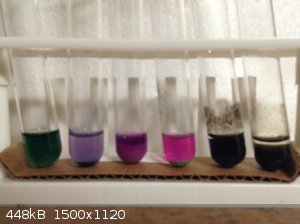
From left to right:
KCl (as a control to ensure that chloride ions don't interfere with the results, it appears they don't as no change took place)
BaCl2 (dark blue precipitate, lavender solution)
CaCl2 (light purple precipitate, but color may come from the solution, magenta solution)
CuSO4 (bluish-gray precipitate, hot pink solution)
NiCl2 (black precipitate, clear solution)
CoSO4 (dark grey precipitate, looks darker in photo, clear solution)
The last two appeared to have reduced the manganate to Mn(IV). I'm not sure what the precipitates are in the middle two tubes. I'd like to think that
they are manganates. The color of the solution above the barium manganate still confuses me also, because it doesn't look like the color of Mn(VII) to
me, unless it's a trick of the light.
Edit: I vacuum filtered the barium manganate, and it does appear that the lavender color of the solution was a trick of the light. Once the solid and
liquid were separated, the solution was clearly the color of Mn(VII), and the precipitate was the dark navy blue color that it is supposed to be. I
really wish that it was possible to make barium manganate more efficiently, because with the current method that I am using an annoying amount of
permanganate is also produced that makes the process quite impractical.
[Edited on 9-1-2014 by zts16]
|
|
|
Texium
Administrator
       
Posts: 4619
Registered: 11-1-2014
Location: Salt Lake City
Member Is Offline
Mood: PhD candidate!
|
|
I left the tubes in the last picture to sit overnight to see if anything interesting would happen, and there were a couple curious things. In the
first tube, which I just added KCl to, the solution has gone completely colorless and an orange precipitate has settled to the bottom of the tube. In
the second tube, which I added barium chloride to, the solution has changed from purple to colorless, while the precipitate remains the characteristic
navy blue of barium manganate. The other tubes haven't changed at all. To confirm that it was indeed the KCl that caused the change in the first tube,
I will set out another tube of only potassium manganate solution overnight to make sure that it wasn't decomposing on its own accord. I'll have a
picture up later.
Quote: Originally posted by chornedsnorkack  |
So, if you produce Mn(IV) in concentrated alkaline solution, do these solutions settle to colourless and clear as MnO2 precipitates out?
Say you apply something reducing to K2MnO4/KOH solution... pure KOH solution is something like 1210 g KOH (22 mol) in 1 kg water at 25 Celsius, and
pure NaOH at 25 Celsius saturates at something like 1110 g NaOH (28 mol) in 1000 g water.
Does your dark green solution go blue, directly green to brown, or directly green to pale green to clear and colourless with solid MnO2 in
precipitate?
|
Also, to answer your earlier question, from what I've observed, such as in the case of adding
K2MnO4 to NiCl2 or CoSO4, the solution changed directly from green to colorless, with the precipitate
appearing almost instantaneously. Despite this, I've also read that sometimes blue MnO4(3-) is briefly seen as in intermediate during the
reduction.
[Edited on 9-2-2014 by zts16]
|
|
|
woelen
Super Administrator
        
Posts: 8027
Registered: 20-8-2005
Location: Netherlands
Member Is Offline
Mood: interested
|
|
The Cl(-) ion acts as reductor and in alkaline conditions you get hydrous MnO2 or even Mn2O3 (the latter is much lighter brown than MnO2). On
acidification this Mn2O3 disproportionates to Mn(2+) ions and MnO2, which in turn at very low pH is capable of oxidizing Cl(-) to Cl2.
|
|
|
chornedsnorkack
National Hazard
   
Posts: 564
Registered: 16-2-2012
Member Is Offline
Mood: No Mood
|
|
Quote: Originally posted by woelen  | | The Cl(-) ion acts as reductor and in alkaline conditions you get hydrous MnO2 or even Mn2O3 (the latter is much lighter brown than MnO2).
|
In strong alkali, do you mean the reaction
KCl+K2MnO4+H2O=KClO+MnO2+2KOH
goes to the right?
Also: adding drops of K2MnO4 to excess of acidic or even neutral solution means you could get unwanted side reactions by dismutation of manganate as
pH drops. Even adding reagent to excess K2MnO4 could cause local pH drops before they mix.
With barium, there would seem to be an obvious alternative: prepare Ba(OH)2 saturated solution, it is fairly soluble and strong base. If you add
K2MnO4 to excess of Ba(OH)2, does the solution remain clear and colour go completely to precipitate?
With reduction, I thought of something like K2SO3/KOH solution, added to excess K2MnO4/KOH solution. What do you get - blue K3MnO4, brown K4MnO4 or
clear K2SO4/KOH over MnO2 precipitate?
|
|
|
Texium
Administrator
       
Posts: 4619
Registered: 11-1-2014
Location: Salt Lake City
Member Is Offline
Mood: PhD candidate!
|
|
Crystallization of Potassium Manganate
I was thinking that allowing a basic solution of potassium manganate to evaporate would leave me with nice green crystals sitting in an
ultra-concentrated NaOH solution that doesn't evaporate because of its deliquescence, but instead it looks like it oxidized to permanganate despite
being in strongly basic solution. Has anyone tried crystallizing this compound before? I know it must be possible, as it is supposedly sold by the
large chemical companies as a green crystalline solid.
I want to do this so that I can then redissolve it in a measured amount of standardized NaOH solution and then continue experimenting with it in a
more controlled way.
[Edited on 10-9-2014 by zts16]
|
|
|
blogfast25
International Hazard
    
Posts: 10562
Registered: 3-2-2008
Location: Neverland
Member Is Offline
Mood: No Mood
|
|
Quote: Originally posted by zts16  | I know it must be possible, as it is supposedly sold by the large chemical companies as a green crystalline solid.
|
You have evidence for that? Manganates are very unstable.
|
|
|
gdflp
Super Moderator
      
Posts: 1320
Registered: 14-2-2014
Location: NY, USA
Member Is Offline
Mood: Staring at code
|
|
http://www.alfa.com/en/catalog/39506 Alfa Aesar sells potassium manganate, but it must not be that simple to make crystals of because it's
pricey, $60/10g or $181/50g
|
|
|
blogfast25
International Hazard
    
Posts: 10562
Registered: 3-2-2008
Location: Neverland
Member Is Offline
Mood: No Mood
|
|
Well, well.
|
|
|
Texium
Administrator
       
Posts: 4619
Registered: 11-1-2014
Location: Salt Lake City
Member Is Offline
Mood: PhD candidate!
|
|
I didn't really take the price into consideration since chemicals from companies like them or Sigma Aldrich are normally quite overpriced.
Oh, and also, I took a look at my small sample of barium manganate that I made a while ago and it too has turned brown. It's supposed to be stable, so
something must have gone wrong, but it's really difficult to tell what since there are so many uncontrolled variables.
|
|
|
Bedlasky
International Hazard
    
Posts: 1243
Registered: 15-4-2019
Location: Period 5, group 6
Member Is Online
Mood: Volatile
|
|
Manganese redox chemistry in strongly alkaline media (hypomanganates, manganates)
Hi everyone  . .
Few days after I attended in discussion about hypomanganates. So I decided prepare hypomanganate again and tested its stability and some redox
chemistry.
So I prepared these three solution: 41% NaOH, 25% Na2S2O3.5H2O in 20% NaOH and approximately 0,0125M KMnO4.
All three solution were cooled to cca 2°C in fridge. After that I added few drops of sodium thiosulfate and six drops of potassium permanganate in to
41% NaOH solution. After that dark violet solution immediately turned colour to dark green by presence of manganate (picture one). I let it stand for
hour in the fridge. After cca 30-40 minutes solution turned colour in to turquoise by presence of hypomanganate (picture two), but I let it stand for
another 20 minutes just for sure that reaction was complete. Solution is now stand in the fridge in plastic beaker with lid and it still have
beautiful turquoise colour (picture three).
I also made some solution of manganate for some redox reaction.
I found in one document effects of manganates and hypomanganates in strongly alkaline media on organic compounds, so I tested some of them. According
to the document - ethanol should reduce manganate in to MnO2 and acetone in to MnO2 through unstable hypomanganate. Ethanol and aceton should reduce
hypomanganate in to MnO2.
I tried reactions betwen strongly alkaline solution of manganate and ethanol/acetone. The reaction with ethanol took some time (few hours). Ethanol
slowly reduced managanate in to MnO2. Acetone after few minutes reduced manganate in to hypomanganate. But reduction in to MnO2 wasn't occurre. The
course of the reaction show pictures 4-8. In the pictures 4-6 is in left test tube manganate/acetone and in right test tube manganate/ethanol. In the
picutres 7-8 is test tubes reverse (I transfered it in to plastic test tubes because i crushed one glass test tube).
In the pictures 9-11 is the same reaction but in hot water bath. Reaction was much quicker, but result was the same.
I tried reduction of hypomanganate by ethanol/acetone, but nothing happened. After few hours in the test tube with ethanol/hypomanganate
disproportionation in to manganate and manganese dioxide has occurred. I tried reduction of hypomanganate by ethanol in hot water bath and it was
slowly reduced in to MnO2 (pictures 12-15). Reaction lasted few minutes.
Last reaction I tried was reducing of hypomanganate by 3% H2O2 in to MnO2. This reaction was very quick and after one minute was complete (picutres
16-17).
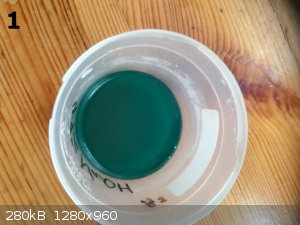  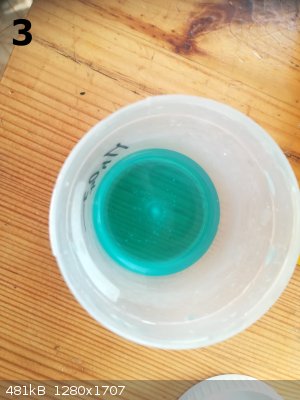 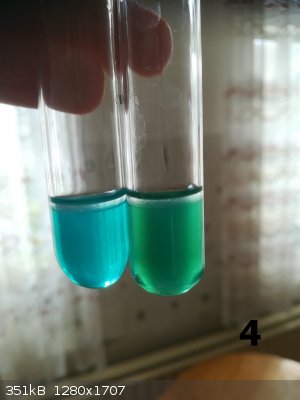   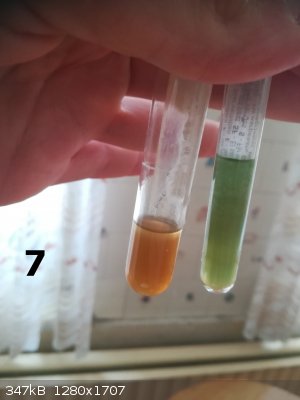 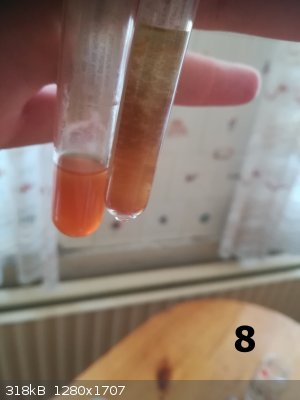  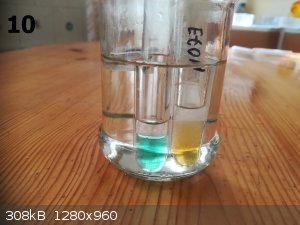 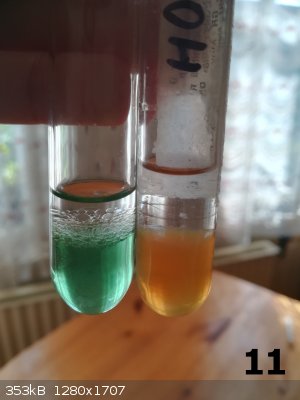    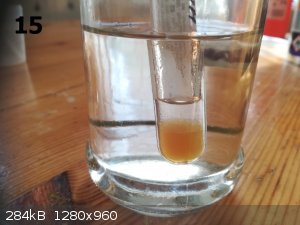  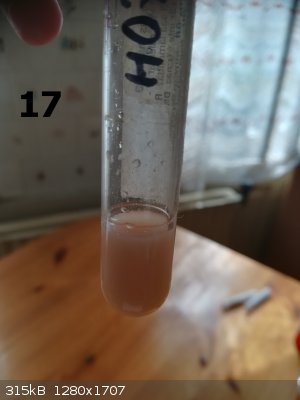
|
|
|
| Pages:
1
2 |